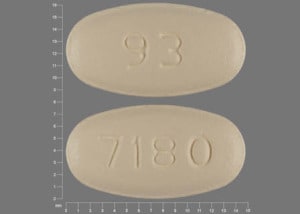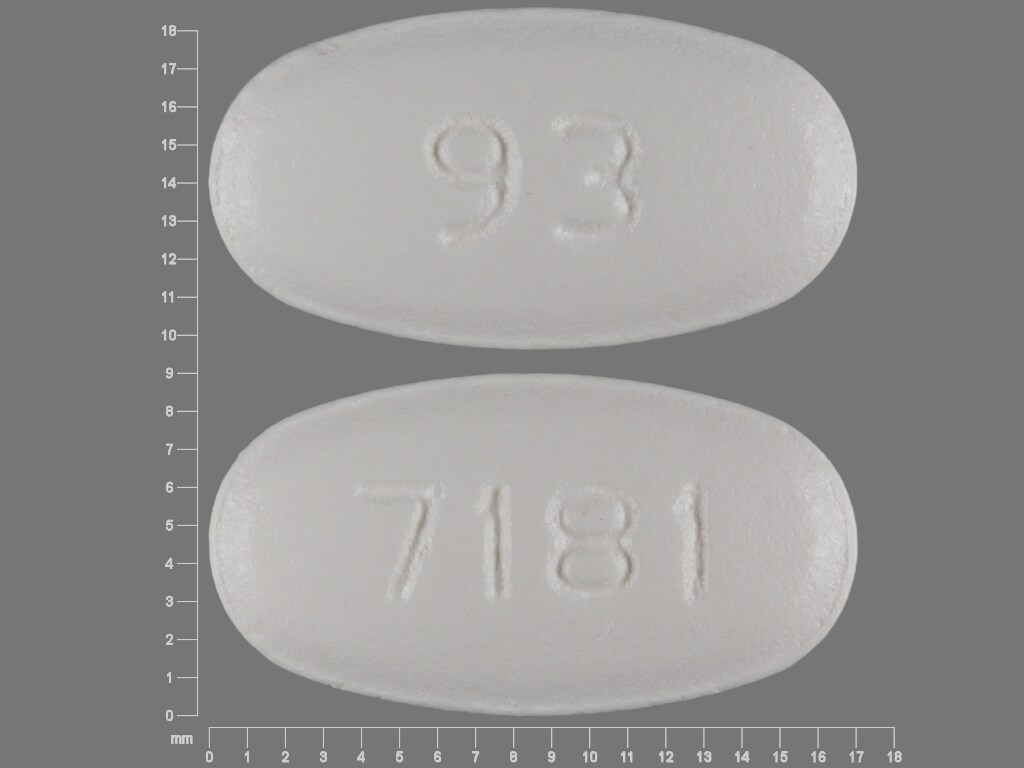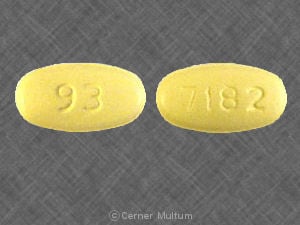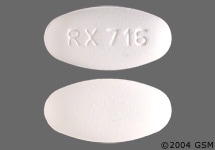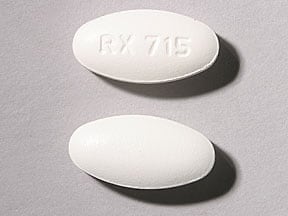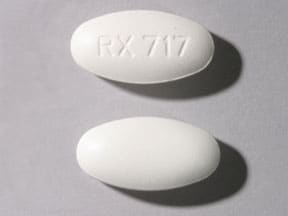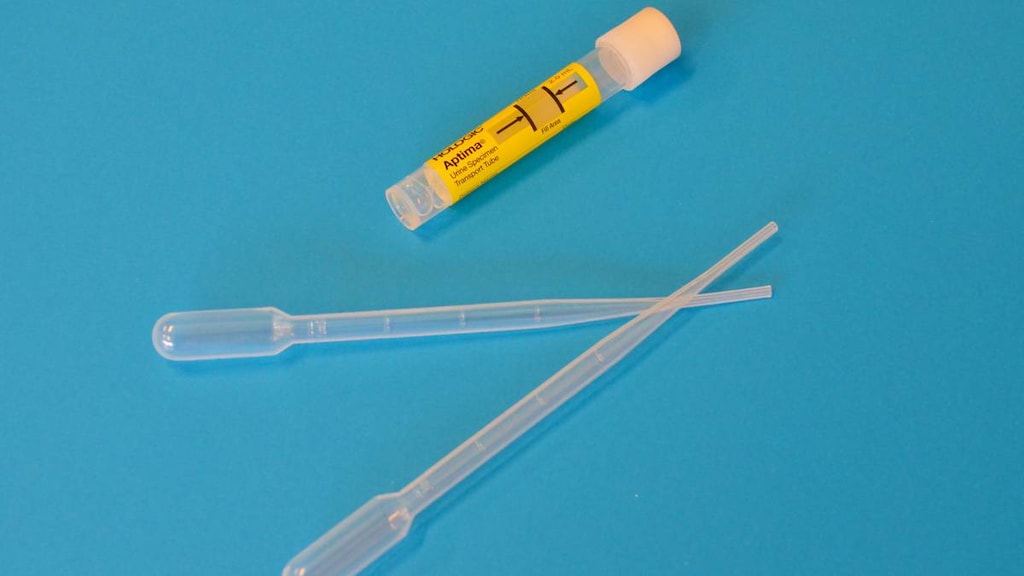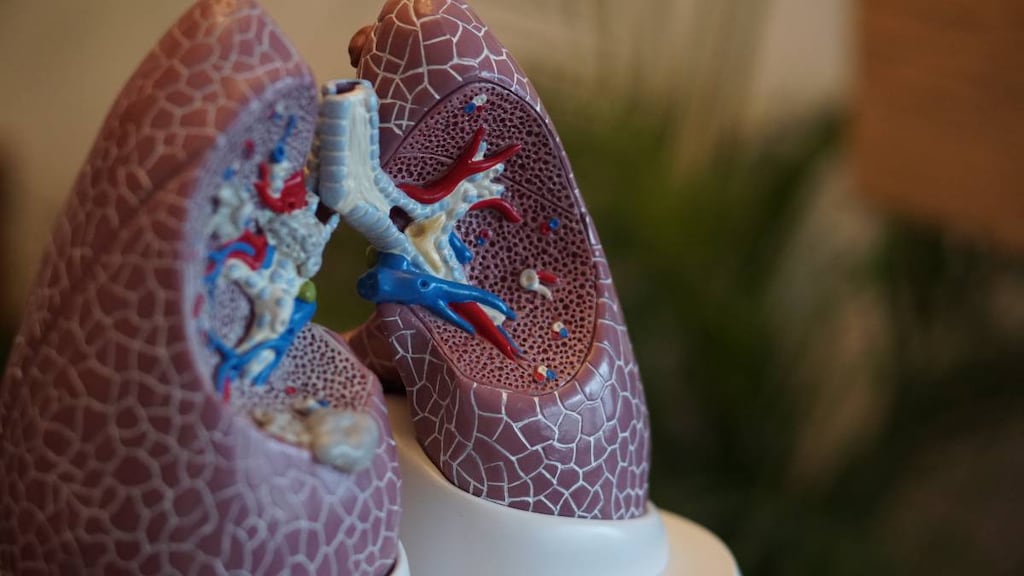Boxed Warning
Tendonitis and tendon rupture:
Fluoroquinolones, including ofloxacin, are associated with an increased risk of tendinitis and tendon rupture in all ages. This risk is further increased in older patients (usually older than 60 years), patients taking corticosteroid drugs, and patients with kidney, heart, or lung transplants.
Myasthenia gravis:
Fluoroquinolones, including ofloxacin, may exacerbate muscle weakness in persons with myasthenia gravis. Avoid ofloxacin in patients with a known history of myasthenia gravis.
Dosage Forms
Excipient information presented when available (limited, particularly for generics); consult specific product labeling.
Tablet, Oral:
Generic: 300 mg, 400 mg
Pharmacology
Mechanism of Action
Ofloxacin is a DNA gyrase inhibitor. DNA gyrase is an essential bacterial enzyme that maintains the superhelical structure of DNA. DNA gyrase is required for DNA replication and transcription, DNA repair, recombination, and transposition; bactericidal
Pharmacokinetics/Pharmacodynamics
Absorption
Well absorbed
Distribution
Widely distributed into body tissues and fluids, including blister fluid, cervix, lung, ovary, prostatic tissue, skin, and sputum; Vd: 2.4 to 3.5 L/kg
Excretion
Urine: 65% to 80% (as unchanged drug); feces: 4% to 8%; <10% is metabolized
Time to Peak
Serum: 1 to 2 hours
Half-Life Elimination
~9 hours (biphasic: 4 to 5 hours [6.4 to 7.4 hours in elderly patients] and 20 to 25 hours [accounts for <5%]); prolonged with renal impairment
Protein Binding
20% to 32%
Use in Specific Populations
Special Populations: Renal Function Impairment
Clearance is reduced in patients with CrCl <50 mL/minute.
Use: Labeled Indications
Treatment of acute exacerbations of chronic bronchitis, community-acquired pneumonia, skin and skin structure infections (uncomplicated), urethral and cervical gonorrhea (acute, uncomplicated), urethritis and cervicitis (nongonococcal) due to Chlamydia trachomatis infection, mixed infections of the urethra and cervix, pelvic inflammatory disease (acute), cystitis (uncomplicated), urinary tract infections (complicated), prostatitis
Note: As of April 2007, the CDC no longer recommends the use of fluoroquinolones for the treatment of gonococcal disease.
Use: Off Label
Epididymitisyes
Based on the Centers for Disease Control and Prevention (CDC) sexually transmitted diseases treatment guidelines and the Canadian Guidelines on Sexually Transmitted Infections, ofloxacin is an effective and recommended treatment option for acute epididymitis likely caused by enteric organisms (as monotherapy). The CDC guidelines also recommend ofloxacin in combination with ceftriaxone for acute epididymitis likely caused by sexually transmitted chlamydia and gonorrhea and enteric organisms in men who practice insertive anal sex.
Leprosy (multibacillary)cyes
Data from a limited number of patients in an open-label, parallel assessment study suggest that ofloxacin, in combination with rifampin and minocycline (ROM), may be beneficial for the treatment of multibacillary leprosy Villahermosa 2004. Additional data may be necessary to further define the role of ofloxacin in this condition.
The World Health Organization Expert Committee on Leprosy (Eighth report) and the National Hansen's Disease Program also supports the use of ofloxacin as a second line agent in the treatment of multibacillary leprosy for patients who cannot take clofazimine (no longer commercially available in the US).
Leprosy (paucibacillary)c
Data from a randomized double-blind trial comparing a daily dose of ofloxacin (in combination with daily doses of rifampin) for 4 weeks with the standard 6-month WHO-MDT regimen supports the use of a daily ofloxacin regimen for this condition Balagon 2010. Another randomized double-blind study suggests the use of single dose ofloxacin, in combination with rifampin and minocycline (ROM), may be beneficial as an alternative treatment regimen for paucibacillary leprosy in patients where careful follow-up for relapse is possible Manickam 2012. Additional trials may be necessary to further define the role of multiple and single dose ofloxacin regimens in paucibacillary leprosy. The World Health Organization Expert Committee on Leprosy and the National Hansen's Disease Program currently do not recommend ofloxacin for the treatment of paucibacillary leprosy.
Spontaneous bacterial peritonitis (treatment)ayes
According to national and international guidelines regarding treatment of spontaneous bacterial peritonitis (SBP), ofloxacin may be considered as an alternative therapy to IV third-generation cephalosporins in patients with uncomplicated SBP who are not infected with a suspected quinolone-resistant organism. If fluoroquinolone-resistant, gram-negative bacteria are suspected as the causative organisms, when fluoroquinolones have been used for prophylaxis, or when patients are located in areas where incidence of quinolone-resistant bacterial infections are high, cefotaxime is the treatment of choice.
Traveler's diarrheayes
Based on the Infectious Diseases Society of America Guidelines for the Practice of Travel Medicine and the American College of Gastroenterology (ACG) Guideline for the Diagnosis, Treatment, and Prevention of Acute Diarrheal Infections in Adults, ofloxacin is an effective and recommended fluoroquinolone for antibiotic treatment of traveler's diarrhea.
Contraindications
Hypersensitivity to ofloxacin, other quinolones, or any component of the formulation
Dosage and Administration
Dosing: Adult
Cervicitis/urethritis: Oral:
Nongonococcal (due to Chlamydia trachomatis): 300 mg every 12 hours for 7 days
Gonococcal (acute, uncomplicated): 400 mg as a single dose; Note: As of April 2007, the CDC no longer recommends the use of fluoroquinolones for the treatment of uncomplicated gonococcal disease.
Chronic bronchitis (acute exacerbation), community-acquired pneumonia, skin and skin structure infections (uncomplicated): Oral: 400 mg every 12 hours for 10 days
Pelvic inflammatory disease (acute): Manufacturer's labeling: 400 mg every 12 hours for 10 to 14 days. Note: The CDC recommends use only if standard cephalosporin therapy is not feasible (patients with severe cephalosporin allergy) and community prevalence of quinolone-resistant gonococcal organisms is low. CDC recommends use in combination with metronidazole. Follow-up and culture and sensitivity must be confirmed (CDC [Workowski 2015]).
Prostatitis: Oral: 300 mg every 12 hours for 6 weeks
UTI: Oral:
Uncomplicated: 200 mg every 12 hours for 3 to 7 days
Complicated: 200 mg every 12 hours for 10 days
Epididymitis (off-label use): Oral:
Likely caused by enteric organisms: 300 mg twice daily for 10 days (CDC [Workowski 2015]) or 200 mg twice daily for 14 days (Canadian STI Guidelines 2008 [Update 2014])
Likely caused by sexually transmitted chlamydia and gonorrhea and enteric organisms in men who practice insertive anal sex: 300 mg twice daily for 10 days in combination with ceftriaxone (CDC [Workowski 2015])
Leprosy (multibacillary) (off-label use): Oral: 400 mg once daily (in combination with dapsone and rifampin) for 12 months (WHO 2012) or alternatively, 400 mg once monthly (in combination with monthly rifampin and minocycline) for 24 months (Villahermosa 2004; WHO 1998; WHO 2012).
Leprosy (paucibacillary) (off-label use): Oral:
Multiple-dose regimen: 400 mg once daily (in combination with rifampin) for 4 weeks (Balagon 2010).
Single-dose regimen: 400 mg as a single dose (in combination with single doses of rifampin and minocycline) (Manickam 2012). Note: Found to be less effective than standard WHO multiple drug therapy (WHO-MDT) for paucibacillary leprosy; should only be used if close follow-up of relapse is possible (Manickam 2012; Setia 2011).
Spontaneous bacterial peritonitis (off-label use): Oral: 400 mg twice daily (AASLD [Runyon 2012]; Navasa 1996)
Traveler's diarrhea (off-label use): Oral: 200 mg twice daily for 1 to 3 days (IDSA [Hill 2006]) or 400 mg once daily as a single dose or for 3 days, with or without loperamide (ACG [Riddle 2016]). If symptoms not resolved after 24 hours, continue with a 3-day therapy course. A 3-day course of therapy is recommended in patients with fever or dysentery; enteric infection due to Shigella dysenteriae is an exception and a 5-day treatment duration is superior to single dose or 3-day regimens (ACG [Riddle 2016]). Note: Fluoroquinolone resistance is increasing; azithromycin may be preferred, particularly in regions such as southeast Asia or India with a high prevalence of Campylobacter (ACG [Riddle 2016]).
Dosing: Geriatric
Refer to adult dosing.
Dosing: Pediatric
Susceptible infection: Limited data available: Children: Oral: 15 mg/kg/day divided every 12 hours (Alghasham 2000)
Administration
Administer with or without food. Do not take within 2 hours of sucralfate, didanosine, iron, zinc, or antacids containing magnesium, calcium, or aluminum.
Storage
Store at 20°C to 25°C (68°F to 77°F).
Ofloxacin (Systemic) Images
Drug Interactions
Aminolevulinic Acid (Systemic): Photosensitizing Agents may enhance the photosensitizing effect of Aminolevulinic Acid (Systemic). Avoid combination
Aminolevulinic Acid (Topical): Photosensitizing Agents may enhance the photosensitizing effect of Aminolevulinic Acid (Topical). Monitor therapy
Amphetamines: May enhance the cardiotoxic effect of Quinolones. Monitor therapy
Antacids: May decrease the absorption of Quinolones. Of concern only with oral administration of quinolones. Management: Avoid concurrent administration of quinolones and antacids to minimize the impact of this interaction. Recommendations for optimal dose separation vary by specific quinolone. Exceptions: Sodium Bicarbonate. Consider therapy modification
BCG (Intravesical): Antibiotics may diminish the therapeutic effect of BCG (Intravesical). Avoid combination
BCG Vaccine (Immunization): Antibiotics may diminish the therapeutic effect of BCG Vaccine (Immunization). Monitor therapy
Blood Glucose Lowering Agents: Quinolones may enhance the hypoglycemic effect of Blood Glucose Lowering Agents. Quinolones may diminish the therapeutic effect of Blood Glucose Lowering Agents. Specifically, if an agent is being used to treat diabetes, loss of blood sugar control may occur with quinolone use. Monitor therapy
Calcium Salts: May decrease the absorption of Quinolones. Of concern only with oral administration of both agents. Exceptions: Calcium Chloride. Consider therapy modification
Cholera Vaccine: Antibiotics may diminish the therapeutic effect of Cholera Vaccine. Management: Avoid cholera vaccine in patients receiving systemic antibiotics, and within 14 days following the use of oral or parenteral antibiotics. Avoid combination
Corticosteroids (Systemic): May enhance the adverse/toxic effect of Quinolones. Specifically, the risk of tendonitis and tendon rupture may be increased. Monitor therapy
Delamanid: Quinolones may enhance the QTc-prolonging effect of Delamanid. Management: Avoid concomitant use if possible. If coadministration is unavoidable, frequent monitoring of electrocardiograms (ECGs) throughout the full delamanid treatment period should occur. Exceptions are discussed in separate monographs. Consider therapy modification
Didanosine: Quinolones may decrease the serum concentration of Didanosine. Didanosine may decrease the serum concentration of Quinolones. Management: Administer oral quinolones at least 2 hours before or 6 hours after didanosine. Monitor for decreased therapeutic effects of quinolones, particularly if doses cannot be separated as recommended. This does not apply to unbuffered enteric coated didanosine. Consider therapy modification
Fexinidazole [INT]: Ofloxacin (Systemic) may enhance the QTc-prolonging effect of Fexinidazole [INT]. Avoid combination
Haloperidol: QT-prolonging Agents (Indeterminate Risk - Avoid) may enhance the QTc-prolonging effect of Haloperidol. Monitor therapy
Heroin: Quinolones may enhance the adverse/toxic effect of Heroin. Monitor therapy
Iron Preparations: May decrease the serum concentration of Quinolones. Management: Give oral quinolones at least several hours before (4 h for moxi- and sparfloxacin, 2 h for others) or after (8 h for moxi-, 6 h for cipro/dela-, 4 h for lome-, 3 h for gemi-, and 2 h for levo-, nor-, oflox-, pefloxacin, or nalidixic acid) oral iron. Exceptions: Ferric Carboxymaltose; Ferric Derisomaltose; Ferric Gluconate; Ferric Hydroxide Polymaltose Complex; Ferric Pyrophosphate Citrate; Ferumoxytol; Iron Dextran Complex; Iron Sucrose. Consider therapy modification
Lactobacillus and Estriol: Antibiotics may diminish the therapeutic effect of Lactobacillus and Estriol. Monitor therapy
Lanthanum: May decrease the serum concentration of Quinolones. Management: Administer oral quinolone antibiotics at least one hour before or four hours after lanthanum. Consider therapy modification
Magnesium Salts: May decrease the serum concentration of Quinolones. Management: Administer oral quinolones several hours before (4 h for moxi/pe/spar-, 2 h for others) or after (8 h for moxi-, 6 h for cipro/dela-, 4 h for lome/pe-, 3 h for gemi-, and 2 h for levo-, nor-, or ofloxacin or nalidixic acid) oral magnesium salts. Consider therapy modification
Methylphenidate: May enhance the cardiotoxic effect of Quinolones. Monitor therapy
Multivitamins/Minerals (with ADEK, Folate, Iron): May decrease the serum concentration of Quinolones. Specifically, polyvalent cations in multivitamin products may decrease the absorption of orally administered quinolone antibiotics. Management: Interactions can be minimized by administering the oral quinolone at least 2 hours before, or 6 hours after, the dose of a multivitamin that contains polyvalent cations (i.e., calcium, iron, magnesium, selenium, zinc). Consider therapy modification
Multivitamins/Minerals (with AE, No Iron): May decrease the serum concentration of Quinolones. Specifically, minerals in the multivitamin/mineral product may impair absorption of quinolone antibiotics. Management: Interactions can be minimized by administering the oral quinolone at least 2 hours before, or 6 hours after, the dose of a multivitamin that contains polyvalent cations (i.e., calcium, iron, magnesium, selenium, zinc). Consider therapy modification
Mycophenolate: Quinolones may decrease the serum concentration of Mycophenolate. Specifically, quinolones may decrease concentrations of the active metabolite of mycophenolate. Monitor therapy
Nadifloxacin: May enhance the adverse/toxic effect of Quinolones. Avoid combination
Nonsteroidal Anti-Inflammatory Agents: May enhance the neuroexcitatory and/or seizure-potentiating effect of Quinolones. Nonsteroidal Anti-Inflammatory Agents may increase the serum concentration of Quinolones. Monitor therapy
Porfimer: Photosensitizing Agents may enhance the photosensitizing effect of Porfimer. Monitor therapy
Probenecid: May decrease the excretion of Quinolones. Specifically, probenecid may decreased the renal excretion of quinolone antibiotics. Probenecid may increase the serum concentration of Quinolones. Monitor therapy
QT-prolonging Agents (Highest Risk): QT-prolonging Agents (Indeterminate Risk - Avoid) may enhance the QTc-prolonging effect of QT-prolonging Agents (Highest Risk). Management: Monitor for QTc interval prolongation and ventricular arrhythmias when these agents are combined. Patients with additional risk factors for QTc prolongation may be at even higher risk. Monitor therapy
Quinapril: May decrease the serum concentration of Quinolones. Management: Separate doses of quinapril and oral quinolones by at least 2 hours in order to reduce the risk of interaction. Monitor for reduced efficacy of the quinolone if these products are used concomitantly. Consider therapy modification
Sevelamer: May decrease the absorption of Quinolones. Management: Administer oral quinolones at least 2 hours before or 6 hours after sevelamer. Consider therapy modification
Sodium Picosulfate: Antibiotics may diminish the therapeutic effect of Sodium Picosulfate. Management: Consider using an alternative product for bowel cleansing prior to a colonoscopy in patients who have recently used or are concurrently using an antibiotic. Consider therapy modification
Strontium Ranelate: May decrease the serum concentration of Quinolones. Management: In order to minimize any potential impact of strontium ranelate on quinolone antibiotic concentrations, it is recommended that strontium ranelate treatment be interrupted during quinolone therapy. Avoid combination
Sucralfate: May decrease the serum concentration of Quinolones. Management: Avoid concurrent administration of quinolones and sucralfate to minimize the impact of this interaction. Recommendations for optimal dose separation vary by specific quinolone. Consider therapy modification
Theophylline Derivatives: Quinolones may decrease the metabolism of Theophylline Derivatives. Ciprofloxacin and enoxacin are of greatest concern. Theophylline/quinolone therapy might augment the seizure-producing potential of each of the individual agents. Exceptions: Dyphylline. Consider therapy modification
Typhoid Vaccine: Antibiotics may diminish the therapeutic effect of Typhoid Vaccine. Only the live attenuated Ty21a strain is affected. Management: Vaccination with live attenuated typhoid vaccine (Ty21a) should be avoided in patients being treated with systemic antibacterial agents. Use of this vaccine should be postponed until at least 3 days after cessation of antibacterial agents. Consider therapy modification
Varenicline: Quinolones may increase the serum concentration of Varenicline. Management: Monitor for increased varenicline adverse effects with concurrent use of levofloxacin or other quinolone antibiotics, particularly in patients with severe renal impairment. International product labeling recommendations vary. Consult appropriate labeling. Monitor therapy
Verteporfin: Photosensitizing Agents may enhance the photosensitizing effect of Verteporfin. Monitor therapy
Vitamin K Antagonists (eg, warfarin): Quinolones may enhance the anticoagulant effect of Vitamin K Antagonists. Monitor therapy
Zinc Salts: May decrease the serum concentration of Quinolones. Management: Give oral quinolones at least several hours before (4 h for moxi- and sparfloxacin, 2 h for others) or after (8 h for moxi-, 6 h for cipro/dela-, 4 h for lome-, 3 h for gemi-, and 2 h for levo-, nor-, pe- or ofloxacin or nalidixic acid) oral zinc salts. Exceptions: Zinc Chloride. Consider therapy modification
Test Interactions
Some quinolones may produce a false-positive urine screening result for opioids using commercially-available immunoassay kits. This has been demonstrated most consistently for levofloxacin and ofloxacin, but other quinolones have shown cross-reactivity in certain assay kits. Confirmation of positive opioid screens by more specific methods should be considered.
Adverse Reactions
1% to 10%:
Cardiovascular: Chest pain (1% to 3%)
Central nervous system: Headache (1% to 9%), insomnia (3% to 7%), dizziness (1% to 5%), fatigue (1% to 3%), drowsiness (1% to 3%), sleep disorder (1% to 3%), nervousness (1% to 3%), pain (trunk)
Dermatologic: Pruritus (≤3%), skin rash (≤3%), genital pruritus (women: 1% to 3%)
Gastrointestinal: Nausea (3% to 10%), diarrhea (1% to 4%), vomiting (1% to 4%), abdominal cramps (1% to 3%), constipation (1% to 3%), decreased appetite (1% to 3%), dysgeusia (1% to 3%), flatulence (1% to 3%), gastrointestinal distress (1% to 3%), xerostomia (1% to 3%)
Genitourinary: Vaginitis (1% to 5%)
Ophthalmic: Visual disturbance (1% to 3%)
Respiratory: Pharyngitis (1% to 3%)
Miscellaneous: Fever (1% to 3%)
<1%, postmarketing, and/or case reports: Abnormal dreams, anaphylaxis, anxiety, auditory disturbance (decreased acuity), blurred vision, chills, cognitive dysfunction, cough, depression, ecchymosis, edema, erythema nodosum, euphoria, exacerbation of myasthenia gravis, Gilles de la Tourette's syndrome, hallucination, hepatic insufficiency, hepatic failure, hepatitis, hepatotoxicity (idiosyncratic; Chalasani 2014), hyperglycemia, hypoglycemia, hypertension, increased intracranial pressure, increased thirst, interstitial nephritis, limb pain, malaise, palpitations, paresthesia, peripheral neuropathy, photophobia, pneumonitis, pseudotumor cerebri, psychotic reaction, rhabdomyolysis, rupture of tendon, seizure, skin photosensitivity, Stevens-Johnson syndrome, syncope, tendonitis, tinnitus, torsades de pointes, toxic epidermal necrolysis, vasculitis, vasodilation, vertigo, weakness, weight loss
Warnings/Precautions
Concerns related to adverse effects:
- Altered cardiac conduction: Fluoroquinolones may prolong QTc interval; avoid use in patients with a history of QTc prolongation, uncorrected hypokalemia, hypomagnesemia, or concurrent administration of other medications known to prolong the QT interval (including Class Ia and Class III antiarrhythmics, cisapride, erythromycin, antipsychotics, and tricyclic antidepressants).
- Aortic aneurysm and dissection: Fluoroquinolones have been associated with aortic aneurysm ruptures or dissection within 2 months following use, particularly in elderly patients. Fluoroquinolones should not be used in patients with a known history of aortic aneurysm or those at increased risk, including patients with peripheral atherosclerotic vascular diseases, hypertension, genetic disorders involving blood vessel changes (eg, Marfan syndrome, Ehlers-Danlos syndrome), and elderly patients, unless no other treatment options are available. Longer treatment duration (eg, >14 days) may increase risk (Lee 2018).
- CNS effects: Fluoroquinolones have been associated with an increased risk of CNS effects including seizures, increased intracranial pressure (including pseudotumor cerebri), dizziness, lightheadedness, and tremors. Use with caution in patients with known or suspected CNS disorders (eg, severe cerebral arteriosclerosis, epilepsy) or other risk factors that may predispose to seizures or lower the seizure threshold.
- Glucose regulation: Fluoroquinolones have been associated with disturbances in glucose regulation, including hyperglycemia and hypoglycemia. These events have occurred most often in patients receiving concomitant oral hypoglycemic agents or insulin. Severe cases of hypoglycemia, including coma and death, have been reported. Diabetic patients should be monitored closely for signs/symptoms of disordered glucose regulation. Discontinue if a hypoglycemic reaction occurs and immediately initiate appropriate therapy.
- Hypersensitivity reactions: Severe, sometimes fatal, hypersensitivity reactions, including anaphylaxis, have occurred with quinolone therapy. The spectrum of these reactions can vary widely; reactions may present as typical allergic symptoms (eg, itching, urticaria, rash, edema) after a single dose, or may manifest as severe idiosyncratic dermatologic (eg, Stevens-Johnson, toxic epidermal necrolysis), vascular (eg, vasculitis), pulmonary (eg, pneumonitis), renal (eg, nephritis), hepatic (eg, hepatic failure or necrosis), and/or hematologic (eg, anemia, cytopenias) events, usually after multiple doses. Prompt discontinuation of drug should occur if skin rash or other symptoms arise.
- Peripheral neuropathy: Peripheral neuropathy has been reported (rare); may occur soon after initiation of therapy and may be irreversible; discontinue if symptoms of sensory or sensorimotor neuropathy occur.
- Phototoxicity: Avoid excessive sunlight and take precautions to limit exposure (eg, loose fitting clothing, sunscreen); may cause moderate to severe phototoxicity reactions. Discontinue use if photosensitivity occurs.
- Psychiatric reactions: Fluoroquinolones have been associated with an increased risk of psychiatric reactions, including toxic psychosis or hallucinations; may also cause nervousness, agitation, confusion, disorientation, delirium, attention disturbances, and memory impairment. Use with caution in patients with a history of or risk factor for depression; discontinue if reaction occurs and institute appropriate therapy.
- Superinfection: Prolonged use may result in fungal or bacterial superinfection, including C. difficile-associated diarrhea (CDAD) and pseudomembranous colitis; CDAD has been observed >2 months postantibiotic treatment.
- Tendon inflammation/rupture: [US Boxed Warning]: There have been reports of tendon inflammation and/or rupture with quinolone antibiotics; risk may be increased with concurrent corticosteroids, organ transplant recipients, and in patients >60 years of age. Rupture of the Achilles tendon sometimes requiring surgical repair has been reported most frequently; but other tendon sites (eg, rotator cuff, biceps) have also been reported. Strenuous physical activity may be an independent risk factor for tendonitis. Discontinue at first sign of tendon inflammation or pain. May occur even after discontinuation of therapy.
Disease-related concerns:
- Hepatic impairment: Use with caution in patients with hepatic impairment.
- Myasthenia gravis: [US Boxed Warning]: May exacerbate muscle weakness related to myasthenia gravis. Cases of severe exacerbations, including the need for ventilatory support and deaths have been reported; avoid use in patients with myasthenia gravis.
- Renal impairment: Use with caution in patients with renal impairment; dosage adjustment required. May increase risk of tendon rupture.
- Rheumatoid arthritis: Use with caution in patients with rheumatoid arthritis; may increase risk of tendon rupture.
- Seizures: Use with caution in individuals at risk of seizures (CNS disorders or concurrent therapy with medications which may lower seizure threshold). Potential for seizures, although very rare, may be increased with concomitant NSAID therapy.
- Syphilis: Since ofloxacin is ineffective in the treatment of syphilis and may mask symptoms, all patients should be tested for syphilis at the time of gonorrheal diagnosis and 3 months later. Note: As of April 2007, the CDC no longer recommends the use of fluoroquinolones for the treatment of uncomplicated gonococcal disease.
Concurrent drug therapy issues:
- Drug-drug interactions: Potentially significant interactions may exist, requiring dose or frequency adjustment, additional monitoring, and/or selection of alternative therapy. Consult drug interactions database for more detailed information.
Special populations:
- Elderly: Adverse effects (eg, tendon rupture, QT changes) may be increased in the elderly.
- G6PD deficiency: Hemolytic reactions may (rarely) occur with quinolone use in patients with latent or actual G6PD deficiency.
Monitoring Parameters
Monitor CBC, renal and hepatic function periodically if therapy is prolonged; signs and symptoms of disordered glucose regulation.
Pregnancy
Pregnancy Risk Factor
C
Pregnancy Considerations
Adverse events have been observed in some animal reproduction studies. Ofloxacin crosses the placenta and produces measurable concentrations in the amniotic fluid. Serum concentrations of ofloxacin may be lower during pregnancy than in nonpregnant patients (Giamarellou 1989). Based on available data, an increased risk of teratogenic effects has not been observed following ofloxacin use during pregnancy (Padberg 2014).
Patient Education
What is this drug used for?
- It is used to treat bacterial infections.
Frequently reported side effects of this drug
- Vomiting
- Diarrhea
- Change in taste
- Nausea
Other side effects of this drug: Talk with your doctor right away if you have any of these signs of:
- Kidney problems like not able to pass urine, blood in the urine, change in amount of urine passed, or weight gain
- Liver problems like dark urine, fatigue, lack of appetite, nausea, abdominal pain, light-colored stools, vomiting, or yellow skin
- Tendon inflammation or rupture like pain, bruising, or swelling in the back of the ankle, shoulder, hand, or other joints
- Nerve problems like sensitivity to heat or cold; decreased sense of touch; burning, numbness, or tingling; pain, or weakness in the arms, hands, legs, or feet
- Depression like thoughts of suicide, anxiety, agitation, irritability, panic attacks, mood changes, behavioral changes, or confusion
- High blood sugar like confusion, fatigue, increased thirst, increased hunger, passing a lot of urine, flushing, fast breathing, or breath that smells like fruit
- Low blood sugar like dizziness, headache, fatigue, feeling weak, shaking, fast heartbeat, confusion, increased hunger, or sweating
- Stevens-Johnson syndrome/toxic epidermal necrolysis like red, swollen, blistered, or peeling skin (with or without fever); red or irritated eyes; or sores in mouth, throat, nose, or eyes
- Chest pain
- Sore throat
- Fast heartbeat
- Abnormal heartbeat
- Dizziness
- Passing out
- Chills
- Thrush
- Muscle pain
- Muscle weakness
- Difficulty focusing
- Trouble with memory
- Sensing things that seem real but are not
- Nightmares
- Trouble sleeping
- Vision changes
- Restlessness
- Seizures
- Severe headache
- Severe loss of strength and energy
- Tremors
- Abnormal gait
- Shortness of breath
- Vaginal pain, itching, and discharge
- Bruising
- Bleeding
- Severe or persistent abdominal pain
- Severe or persistent chest pain
- Severe or persistent back pain
• Clostridioides (formerly Clostridium) (C. diff)-associated diarrhea (abdominal pain or cramps, severe diarrhea or watery stools, or bloody stools)
- Signs of a significant reaction like wheezing; chest tightness; fever; itching; bad cough; blue skin color; seizures; or swelling of face, lips, tongue, or throat.
Note: This is not a comprehensive list of all side effects. Talk to your doctor if you have questions.
Consumer Information Use and Disclaimer: This information should not be used to decide whether or not to take this medicine or any other medicine. Only the healthcare provider has the knowledge and training to decide which medicines are right for a specific patient. This information does not endorse any medicine as safe, effective, or approved for treating any patient or health condition. This is only a brief summary of general information about this medicine. It does NOT include all information about the possible uses, directions, warnings, precautions, interactions, adverse effects, or risks that may apply to this medicine. This information is not specific medical advice and does not replace information you receive from the healthcare provider. You must talk with the healthcare provider for complete information about the risks and benefits of using this medicine.
